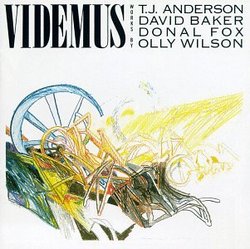A gem of soulful modernism
Max T. Shea | Amherst, MA | 03/21/2009
(5 out of 5 stars)
"
Videmus was an ensemble directed by pianist Vivian Taylor as a vehicle for the advancement of "minority" composers.
I discovered this release in my search for works by composer Olly Wilson and for me, a lover of electronic music, Wilson's "Sometimes" is a rewarding listen. Wilson wrote "Sometimes" with the tenor William Brown in mind. The piece is based on the Black spiritual "Sometimes I Feel Like a Motherless Child." The tape whirs, taps, and hisses interweaving with Brown's plaintive intonations. Wilson and Brown capture the dark viscera of the spiritual's message in a way that augments the power of the song itself.
"Motherless Child" and the voice of William Brown return on Videmus as part of jazz composer David Baker's powerful song cycle "Through This Vale of Tears," which is a commemoration of the death of Dr. Martin Luther King. The highlight of this cycle of seven songs lies in the ironic text of the last one, "Now That He is Safely Dead," by poet Carl Hines: "Now that he is safely dead, we, with eased consciences will teach our children he was a great man. Knowing that the cause for which he lived is still a cause. And the dream for which he died is still a dream."
Donal Fox is another African-American composer featured on Videmus with four different pieces for piano and for piano with wind instruments. The best of these is "Jazz Sets and Tone Rows," which takes its inspiration from Olly Wilson's "Sometimes" and features the iconic saxophonist Oliver Lake on alto sax. Fox achieves a masterfully difficult fusion between jazz and serialism.
T.J. Anderson's sole piece on Videmus is his "Intermezzi" for clarinet, saxophone, and piano, a scoreless piece divided into several resonant sections with each section played independently of the others. The composer compares his method to listening to several conversations in the same room. The subsequent pieces, Fox's "Four Chords from T.J.'s Intermezzi" and "Duetto for Clarinet and Piano" are based on Anderson's contribution.
Thus, in Videmus, we have more than a collection, but an interconnected suite based on musical and conceptual themes."


 Track Listings (13) - Disc #1
Track Listings (13) - Disc #1